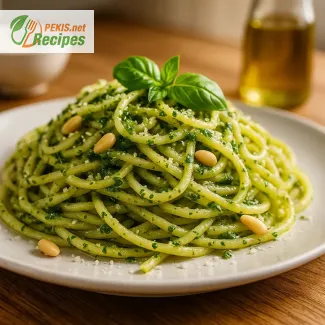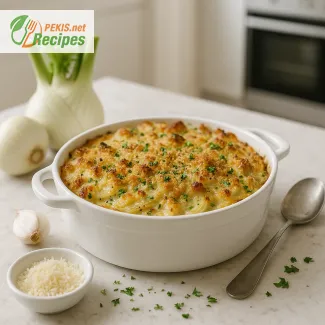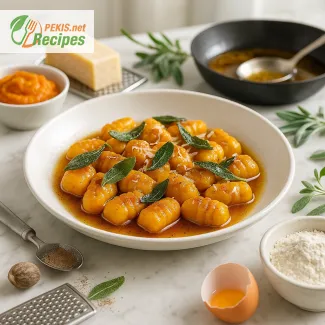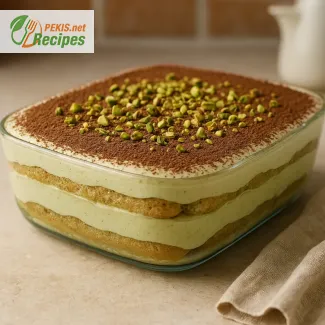Serves 4, ready in 25 minutes with 15 minutes prep and 10 minutes cook time. Fresh basil, extra virgin olive oil, pine nuts, and two Italian cheeses create a silky, vibrant pesto coating al dente pasta. A true Genovese classic with bright herbal notes and a creamy, nutty finish.
PEKIS – professional chef and recipe developer with over 25 years of experience, specializing in European and international cuisine. This pasta recipe has been tested multiple times in both home and professional kitchens, with special attention to preserving the authentic texture and flavor balance of traditional Ligurian pesto.

Mastering the Flavor of Genovese Pesto Pasta
Traditional Ligurian heritage in every bite
Delicate strands of pasta coated in a vibrant green sauce release an aroma that instantly recalls the sunny terraces of Liguria. The silky emulsion of fresh basil, extra virgin olive oil, aged Parmigiano Reggiano, and toasted pine nuts clings to each piece, creating a balanced bite where herbal brightness meets nutty depth. The key lies in the harmony of simple, high-quality ingredients—each one playing its part without overpowering the others.
Originating from Genoa in the Italian Riviera, pesto alla Genovese is a culinary tradition that dates back to the 19th century, though its herbal predecessors can be traced to Roman times. In Ligurian kitchens, the sauce was originally prepared with a marble mortar and wooden pestle, ensuring a slow grinding that preserved the basil’s essential oils. Today, while food processors may have replaced the mortar, the spirit of the recipe remains the same: a celebration of freshness and simplicity.
Authentic texture and flavor balance
The soul of pesto pasta lies in texture as much as flavor. The basil leaves should be young and tender, giving the sauce its signature sweetness without bitter undertones. Pine nuts add creaminess, while a mix of Parmigiano Reggiano and Pecorino Sardo introduces a savory sharpness. The olive oil should be smooth and fruity, never overpowering. The pasta, traditionally trofie or trenette, is cooked al dente so it holds the sauce without becoming heavy.
Tips for perfect results:
- Always reserve a little pasta cooking water to help emulsify the sauce.
- Avoid overheating the pesto to preserve its vibrant color and fresh taste.
- Toss pasta and pesto together gently but thoroughly to ensure even coating.
Storage & Make-Ahead
- Room temperature: Up to 2 days, stored in an airtight container away from direct sunlight.
- Refrigeration: 3–4 days in an airtight container, with a thin layer of olive oil on top to prevent oxidation.
- Freezing: Up to 2 months, ideally in small portions for quick use.
- Reheating: Oven at 150 °C (300 °F) for 8–10 minutes, or gently warmed in a pan with a splash of water.
Why you’ll love this recipe
- Rich Ligurian tradition that connects you to the origins of Italian coastal cuisine.
- Bright, fresh flavors from basil and quality olive oil.
- Versatile pairing with various pasta shapes and proteins.
- Quick preparation ideal for weeknight dinners.
- Easily scalable for family gatherings or intimate meals.
Ingredient harmony and cultural roots
This dish is more than just pasta and sauce—it’s a representation of Liguria’s maritime and agricultural heritage. The use of basil reflects the region’s sunny climate, pine nuts speak to Mediterranean forests, and the cheeses link to centuries of Italian dairy craftsmanship. Even the pasta shapes traditionally used are influenced by seafaring traditions, designed to hold sauce well during long voyages or festive meals.
By respecting these origins while embracing modern conveniences, Pesto Genovese Pasta remains a timeless staple that appeals to both purists and home cooks seeking a burst of Mediterranean freshness on their table.
- Prepare the pesto: Place fresh basil leaves, pine nuts, and minced garlic into a mortar and pestle or a food processor. Gently grind or pulse until coarsely combined.
- Incorporate the cheeses: Add grated Parmigiano Reggiano and Pecorino Sardo, mixing slowly to preserve texture and aroma.
- Emulsify with olive oil: Pour in extra virgin olive oil in a slow stream while mixing, creating a smooth yet slightly textured sauce. Avoid overheating to keep the basil vibrant green.
- Cook the pasta: Bring a large pot of salted water to a boil, add spaghetti or linguine, and cook until al dente according to package instructions.
- Combine pasta and sauce: Reserve 60 ml (¼ cup) of pasta cooking water before draining. Toss pasta with pesto, adding cooking water gradually to achieve a silky, evenly coated texture.
- Serve immediately: Plate the pasta while warm, optionally topping with extra grated cheese and a drizzle of olive oil.
FAQ questionCan I make pesto in advance?
Yes, pesto can be prepared up to 3–4 days ahead and stored in the refrigerator in an airtight container. Cover the surface with a thin layer of olive oil to prevent oxidation and preserve color.
FAQ questionWhat pasta shapes work best with pesto?
Traditional Ligurian pasta shapes such as trofie or trenette are ideal, but spaghetti, linguine, or fusilli also hold the sauce well.
FAQ questionCan I use a blender instead of a mortar and pestle?
Yes, but pulse in short bursts to avoid heating the basil, which can cause discoloration and a bitter taste.
FAQ questionIs it possible to make nut-free pesto?
Absolutely – replace pine nuts with pumpkin seeds or sunflower seeds for a similar creamy texture without nuts.
FAQ questionCan I freeze pesto?
Yes, portion into small airtight containers or ice cube trays and freeze for up to 2 months. Thaw in the refrigerator before using, and avoid reheating directly to maintain flavor.
FAQ questionWhy is my pesto turning brown?
Basil oxidizes quickly when exposed to air. Use fresh leaves, avoid prolonged blending, and store with olive oil covering the surface to keep its bright green color.
FAQ questionCan I make this recipe vegan?
Yes, replace Parmigiano Reggiano and Pecorino Sardo with nutritional yeast and a pinch of salt for a dairy-free alternative.
FAQ questionWhat is the secret to a creamy sauce?
The key is to emulsify the pesto with a little pasta cooking water, which binds the sauce to the pasta and creates a silky coating.
Elevating the Flavor and Texture of Genovese Pesto Pasta
Enhancing aroma, balance, and freshness
The beauty of Genovese pesto pasta lies in its balance of herbal brightness, nutty richness, and salty sharpness. While the traditional recipe is celebrated for its simplicity, small adjustments can make it even more memorable. Selecting young, tender basil leaves from the top of the plant ensures a sweeter, more delicate flavor. Pairing this with freshly grated Parmigiano Reggiano and Pecorino Sardo preserves the authentic Ligurian profile while adding depth. For the creamiest texture, grind or blend the basil with pine nuts just until coarse, then emulsify with extra virgin olive oil in slow, steady additions.
Ingredient upgrades for a deeper flavor profile
Choosing the highest quality ingredients is the foundation of an improved dish. Extra virgin olive oil with a smooth, fruity character enhances the pesto without overpowering it. Lightly toasting pine nuts before blending can release aromatic oils and intensify the nutty undertone. For an added twist, a small amount of lemon zest or a splash of juice can brighten the flavor without disrupting the traditional balance. When possible, source DOP-certified cheeses for authentic taste.
Why homemade preparation excels over store-bought
Freshly made pesto retains the vibrant green color and delicate aroma that often fade in pre-packaged versions. The natural oils in basil begin to oxidize quickly after blending, which is why preparing the sauce just before serving delivers the most vivid flavors. Homemade pesto also allows control over texture—whether you prefer a slightly chunky sauce or a silky, smooth finish.
Common mistakes to avoid
Overprocessing basil generates heat, which can dull the flavor and cause browning. Always pulse gently or grind by hand in a mortar and pestle. Adding all the oil at once can lead to separation; instead, incorporate it gradually to create a stable emulsion. Salting the pasta water sufficiently is crucial—this is the only opportunity to season the pasta itself before it’s coated in sauce. Avoid reheating pesto over direct heat, as this can alter the flavor and color.
Health-conscious and dietary adaptations
For a lighter version, replace part of the olive oil with vegetable broth to reduce fat content while maintaining a creamy consistency. Those avoiding dairy can substitute nutritional yeast for cheese, which preserves the umami notes. For nut-free diets, swap pine nuts with pumpkin seeds or sunflower seeds—both offer creaminess with a slightly different flavor. To make the dish gluten-free, choose pasta made from rice, corn, or legumes without compromising the pesto’s ability to coat the noodles.
Balancing sauce and pasta for perfect coating
The secret to achieving the ideal consistency lies in using pasta cooking water. The starch in this water helps bind the sauce to the pasta, creating a luxurious coating. Add the reserved water a little at a time while tossing the pasta in the pesto, ensuring the sauce clings evenly. Using traditional pasta shapes such as trofie or trenette allows the sauce to nestle into every curve and twist.
Adding a signature twist without losing authenticity
A sprinkle of crushed pink peppercorns or a drizzle of herb-infused olive oil can elevate presentation and flavor. For added texture, garnish with a few whole toasted pine nuts or basil leaves. If serving as part of a multi-course meal, complement the dish with lightly grilled vegetables or a fresh tomato salad to balance the richness of the pesto.
Serving tips for maximum enjoyment
Serve Genovese pesto pasta immediately after combining the sauce and noodles to preserve the basil’s aromatic freshness. Warm plates help maintain temperature without reheating the sauce. Pair with a crisp white wine like Vermentino or a chilled sparkling water with lemon to cleanse the palate between bites. This combination enhances the herbal, nutty notes of the pesto and completes the dining experience.
Allergens present in the recipe
- Milk (cheese)
- Tree nuts (pine nuts)
- Gluten (pasta)
Tips for replacing allergenic ingredients
- Replace cheese with nutritional yeast for a dairy-free version.
- Replace pine nuts with sunflower seeds or pumpkin seeds for nut-free adaptation.
- Use gluten-free pasta made from rice, corn, or legumes to make the dish gluten-free.
Vitamins and minerals per serving (approximate)
- Vitamin A: 950 IU – supports eye health and immune system.
- Vitamin K: 100 µg – essential for blood clotting and bone strength.
- Vitamin C: 10 mg – boosts immune defense and aids collagen production.
- Calcium: 180 mg – important for bone density and muscle function.
- Iron: 2.5 mg – contributes to oxygen transport in the blood.
- Magnesium: 45 mg – supports muscle relaxation and nerve function.
Antioxidants per serving (approximate)
- Lutein: 1.2 mg – protects eyes from oxidative stress.
- Beta-carotene: 1.0 mg – supports skin health and immune resilience.
- Vitamin E: 2.5 mg – helps protect cells from free radical damage.





